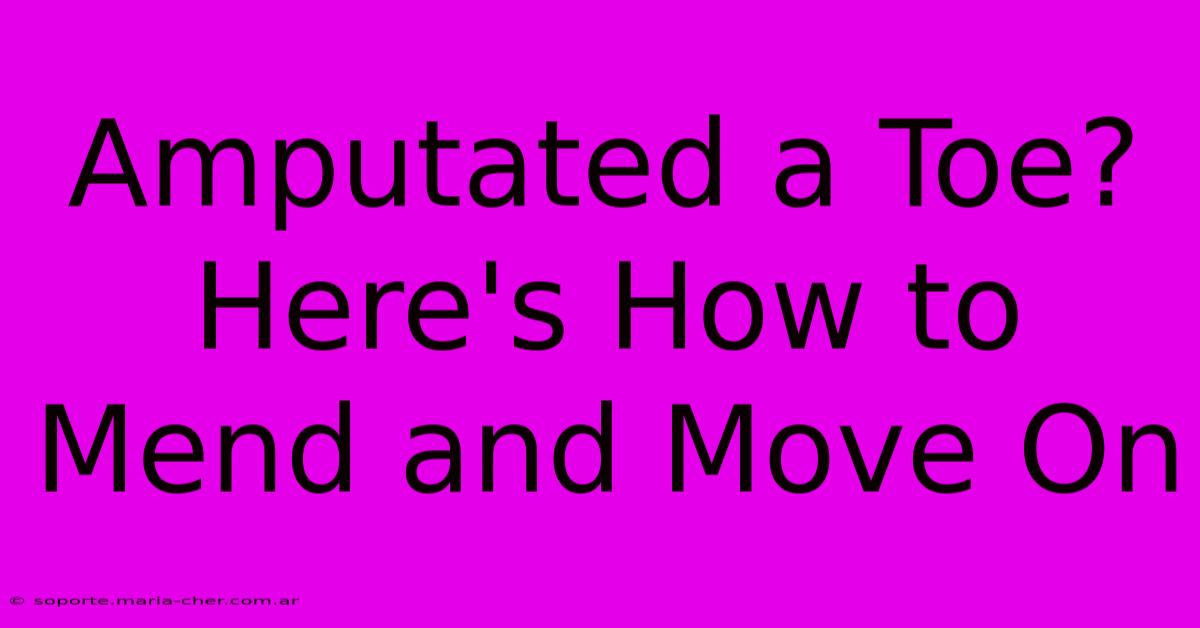Amputated A Toe? Here's How To Mend And Move On

Table of Contents
Amputated a Toe? Here's How to Mend and Move On
Losing a toe, whether through accident, injury, or illness, is a significant event. It impacts your physical abilities, your body image, and your emotional well-being. This article provides guidance on navigating the recovery process, both physically and emotionally, after toe amputation.
Understanding Toe Amputation
Toe amputations can range from partial (removing a portion of a toe) to complete (removing an entire toe). The reasons for amputation vary, including:
- Severe trauma: Accidents, crush injuries, or severe frostbite.
- Circulatory problems: Diabetes, peripheral artery disease (PAD), and other vascular conditions that compromise blood flow to the toes.
- Infections: Untreated infections can lead to gangrene, requiring amputation to prevent the spread of infection.
- Tumors: Cancerous or non-cancerous tumors may necessitate toe amputation.
- Congenital deformities: Some individuals are born with deformities that require surgical intervention.
The Recovery Process: Physical Healing
The recovery process after toe amputation varies depending on the extent of the surgery, your overall health, and your adherence to the doctor's instructions. Here's what you can expect:
Immediate Post-Surgery:
- Pain Management: Your medical team will prescribe pain medication to help manage discomfort. Be sure to take medication as directed.
- Wound Care: The surgical site will require careful cleaning and dressing changes. Your doctor or nurse will provide specific instructions. Meticulous wound care is crucial to prevent infection.
- Elevation: Keeping your foot elevated helps reduce swelling and promote healing.
- Mobility: You'll likely need assistance with mobility initially, possibly using crutches or a walker. Physical therapy will play a vital role in regaining mobility.
Rehabilitation and Physical Therapy:
- Range of Motion Exercises: Gentle range-of-motion exercises will be prescribed to maintain flexibility and prevent stiffness in your foot and ankle.
- Strengthening Exercises: Once the wound has healed, you'll begin strengthening exercises to build muscle strength and improve balance.
- Gait Training: Your physical therapist will help you relearn how to walk comfortably and safely, potentially using assistive devices as needed.
- Custom Orthotics: In some cases, custom orthotics may be recommended to provide support and cushioning to your foot.
The Emotional Journey: Coping and Adjustment
Losing a toe can be emotionally challenging. It's normal to experience:
- Grief and Loss: The loss of a body part can evoke feelings of grief and loss, even if the amputation was necessary to save your life.
- Body Image Issues: Changes in body image are common after amputation. It's important to allow yourself time to adjust to your new body.
- Anxiety and Depression: Anxiety and depression are possible complications, especially in the early stages of recovery. Don't hesitate to seek professional support if needed.
Strategies for Emotional Healing:
- Support Groups: Connecting with others who have undergone similar experiences can provide valuable support and understanding.
- Therapy: A therapist can help you process your emotions, cope with grief, and develop strategies for managing anxiety and depression.
- Self-Care: Prioritizing self-care activities, such as exercise, healthy eating, and relaxation techniques, can significantly improve your emotional well-being.
Moving Forward: Adapting to Life After Toe Amputation
Adapting to life after toe amputation takes time and patience. Here are some tips:
- Adaptive Footwear: You may need specially designed shoes or orthotics to accommodate your altered foot structure.
- Occupational Therapy: Occupational therapy can help you adjust to daily tasks and activities that may be more challenging after amputation.
- Return to Work/Activities: The timing of your return to work or other activities will depend on your recovery progress. Work with your doctor and physical therapist to determine a safe and appropriate timeline.
- Positive Mindset: Maintaining a positive mindset and focusing on your progress is essential for a successful recovery.
Losing a toe is a significant life event. However, with proper medical care, rehabilitation, and emotional support, you can mend, move on, and regain a fulfilling life. Remember to be patient with yourself, celebrate your progress, and seek help when needed. The journey to recovery is individual; focus on your own pace and celebrate every milestone along the way.

Thank you for visiting our website wich cover about Amputated A Toe? Here's How To Mend And Move On. We hope the information provided has been useful to you. Feel free to contact us if you have any questions or need further assistance. See you next time and dont miss to bookmark.
Featured Posts
-
Nail Envy Elevate Your Manicures With The Best Builder Gels For Professionals
Feb 09, 2025
-
Unlock Salon Perfect Nails At Home The Ultimate Guide To Best Builder Gels
Feb 09, 2025
-
Make Every Thank You A Meaningful Memory With Our Personalized Kids Thank You Cards
Feb 09, 2025
-
Dont Overpay Unraveling The Mysteries Of Knee Scope Surgery Pricing
Feb 09, 2025
-
Cognitive Dissonance The Uncomfortable Truth That Drives Behavior
Feb 09, 2025
